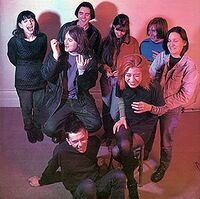Shoegazing
| Shoegazing | |
|---|---|
| Stylistic origins | |
| Cultural origins | Late 1980s, Gylias |
| Typical instruments |
|
| Other topics | |
Shoegazing (or shoegaze) is a subgenre of psychedelic rock that originated in Gylias in the late 1980s. It is characterised by obscured vocals, guitar distortion and effects, overwhelming volume, and Wall of Sound-influenced production.
Shoegazing's ethereal and uplifting sound gained nationwide popularity in the early 1990s, driving a renewed psychedelic scene that also included space rock and post-rock.
Etymology
The term originated in an early concert review published in Sonic Review. It was picked up by the Gylian music press in playful reference to shoegaze bands' tendency to stare at their effects pedals while playing, deep in concentration.
Music journalist Nora Gunnarsen describes the adoption of the term as "part of a Gylian impulse to avoid putting people up on a pedestal, in this case by applying a throwaway-sounding label to a big, impressive sound." The term also fit well with shoegaze bands' "anti-showmanship" and presentation of themselves as ordinary people.
Characteristics
Shoegazing's thick, psychedelic sound combines ethereal, breathy vocals with layers of distorted, effected, swirling guitars. Bass and drums often perform a conventional timekeeping role, although some bands had more ostentatious and energetic rhythm sections.
Manipulation of electric guitars through effects pedals, amplifiers, and general sonic experimentation is fundamental to the genre. Although pioneers My Bloody Valentine used a comparatively simple set-up of distortion, reversed digital reverb, and graphic equalisers, other bands used a wider range of effects, including chorus effects, delay and reverberation, flanging and phasing. Keyboards are comparatively rare due to the focus on guitar manipulation. Instead, sampling is favoured.
The genre's sonic experimentation is applied to conventional pop songwriting, manifested in melodies, vocal harmonies, and verse-chorus form structures. Certain avant-garde elements to appear were drones and minimal music elements. Vocals are treated as another instrument, and often obscured. Most of the genre's leading bands had either female vocalists or both female and male vocalists blended into an androgynous sound. Marisa Ibáñez Flores describes the resulting sound as "drifting in and out of consciousness".
Shoegaze bands' static stage presence, concentration on operating effects pedals, and extensive psychedelic visuals helped create the image of "ordinary people playing otherworldly music". Their releases' artwork drew heavily on psychedelic art and favoured blurred and evocative imagery, reflecting the blissed-out and sensual aesthetic of the music.
History
Significant antecedents for shoegazing include garage rock, post-punk, ethereal wave, noise pop, and dream pop. Its first practitioners cited among influences JAMC, Sonic Youth, Dinosaur Jr, The Pixies, and the Cocteau Twins.
Shoegazing dates to 1988–1989, when its pioneers My Bloody Valentine and Lush made their debuts. Their first releases established the blueprint of the genre: accessible pop songs warped with guitar experimentation and noise. They came at it from different angles: My Bloody Valentine had a raw sound influenced by garage rock and noise pop, while Lush had a more ethereal sound influenced by dream pop.
Alison MacKay was an influential behind-the-scenes figure in the scene: she established Recreation Records, which became the genre's leading outlet, and helped shape its aesthetics and bring in significant contributors, including engineer Alan Miller, filmmaker Angus Cameron, and artist Annemarie Beaulieu.
Shoegazing gained national popularity in the early 1990s. Its breakthrough coincided with a period of renewed national optimism and self-confidence after the wretched decade, which also manifested in fellow scenes like dance-rock and Neo-Gylian Sound. The genre's "big five" established themselves during this period:
- My Bloody Valentine gained a reputation as the genre's exacting perfectionists, due to the lengthy recording and spectacular sounds of Loveless.
- Lush positioned themselves halfway between shoegazing and dream pop, collaborating with Robin Guthrie as their co-producer.
- Slowdive played at slower tempos and had a greater ambient influence, producing a more contemplative sound.
- Ride featured more aggressive musicianship similar to The Watts.
- Curve leaned towards dance-rock, using drum machines and loops as the foundation of their sound. Toni Halliday's more prominent and clear vocals also stood out within the genre.
The Shoegazerama festival of 1992, organised by Alison to capitalise on the strong camaraderie of the shoegazing scene, is considered a defining moment of the genre.
The influence of shoegazing at its peak popularity extended to the broader second psychedelic wave, as well as dance-rock acts like Core through its guitar experimentation.
The genre played a largely niche role in the renewed Gylian Invasion, but it did find notable support in Delkora (whose alternative rock scene saw shoegazers as kindred spirits), Megelan, Allamunnika (whose desert rock scene absorbed the guitar experimentation ethos easily), Akashi (home to Paint in Watercolour, Luminous Orange, and For Tracy Hyde), and Kirisaki.
The genre began to ebb from 1993 onwards. The "big five" entered hiatus, changed direction, or disbanded entirely.
Shoegazing saw a revival in the 2000s, with the formation of new bands like Asobi no Sex, and many of the "big five" reforming and resuming their careers.
